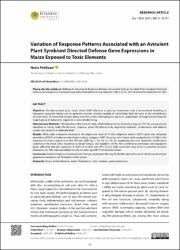Variation of response patterns associated with an avirulent plant symbiont directed defense gene expressions in maize exposed to toxic elements
Citation
Pehlivan, N. (2021). Variation of response patterns associated with an avirulent plant symbiont directed defense gene expressions in maize exposed to toxic elements. European Journal of Biology, 80(1), 35-41. http://doi.org/10.26650/EurJBiol.2021.871829Abstract
Objective: Microbe-assisted plant heavy metal (HM) tolerance is gaining momentum over a conventional breeding or transgenic approach being used to generate tolerant varieties capable of completing their life cycle in the metalliferous environments. To withstand toxicity, along with the current anthropogenic pressure, applications of fungi representing the largest group of eukaryotic organisms is considerably rising. Materials and Methods: The hypothesis that a novel strain, which belongs to the Trichoderma genus (TS143), was previously identified as being multi HM-resistant, improves plant HM-tolerance by regulating hydraulic conductance and defense system was tested at a molecular level. Results: While only a marginal increase in the expression level of 70 kDa chaperon protein (HSP1) gene was obtained, peroxidase (POD1) and plasma membrane intrinsic aquaporin (PIP1-5) genes were found to be upregulated (<2 fold) in the presence of chronic exposure to the HM-mix, (500 mg L-1 As, Cd, Cu, Pb, Zn) explaining the vivid metabolic modification underlying the metal stress response by target fungus. Up-regulation of the ROS-scavenging peroxidase and aquaporin genes affirming that the responses of POD1 (9.44 fold) and PIP1-5 (3.55 fold) expression may serve as potential sensitive biomarkers for HM-induced cellular toxicity monitoring with TS143 biostimulation. Conclusion: Determining transcriptional level changes might pave the way for further applied research which would analyze gene level interactions of Trichoderma-HMs-plants.


















